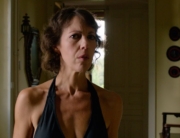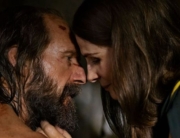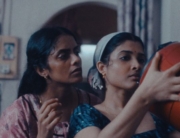
Noted for her contemporary explorations of young womanhood (Water Lilies), acclaimed French filmmaker Céline Sciamma turns to period drama with this elegant meditation on female desire that flips the script on the male gaze. With the exception of an off-screen suitor, men are nearly absent from the story line, and women’s longing to see and be seen drives the plot.
In an 18th-century world where most women are relegated to the kitchen as servants or to the boudoir as wives or mistresses, Marianne (Noémie Merlant) makes her living as a portrait painter, much like the prominent female portraitist of the era, Élisabeth Louise Vigée Le Brun (1755–1842). As the movie opens, Marianne is teaching several aristocratic young women how to draw a sketch of her, advising them to “take time to look at me.” One student asks about a canvas she has uncovered, a painting of a woman with her skirt ablaze, and the scene dissolves into a flashback of Marianne arriving by rowboat to an island off the coast of Brittany. Viewers glimpse the young artist’s fearless and unconventional nature when she leaps into the water to retrieve a lost box of precious art supplies. A bedraggled Marianne determinedly drags her canvases up from the beach to the isolated chateau of her new employer.
An Italian countess (Valeria Golino) has commissioned Marianne to paint a portrait of her daughter, Héloïse (an intense Adèle Haenel), that she plans to send to a wealthy potential husband in Milan. But she instructs Marianne to pretend to be the girl’s companion and do her work in secret. Her male predecessor had been thwarted by the headstrong Héloïse’s refusal to sit for him. Later in her studio, Marianne discovers his unsettling, unfinished faceless image of Héloïse.
Surreptitiously sketching her subject during a series of walks and conversations, Marianne initially is unaware that she too is being studied. “When you’re observing me, who do you think I’m observing?” asks Héloïse, after Marianne’s true purpose is revealed. She also mocks the final result, which has failed to capture her spirit, “Is that how you see me?” Frustrated, Marianne destroys both her work and that of her predecessor. (The paintings are by artist Helene Delmaire.)
In spite of her defiance of her mother’s marital wishes, Héloïse agrees to sit for Marianne, actively collaborating in the creation of a stunning portrait that will seal her fate. As the two gradually fall in love, their subtle glances and touches turn erotic with tenderness and delicacy. But Marianne’s visions of a ghostly Héloïse in white mars the idyllic bliss of their romance.
A subplot involving Sophie the maid (Luana Bajrami) allows the director to explore the possibilities of what life would be like if women were free of male dominance. After Sophie has an abortion (one wonders how she got pregnant on an island with no men), Marianne and Héloïse become her caretakers, and the trio briefly live in a classless, matriarchal paradise. While some viewers might find this to be anachronistic and slightly heavy-handed, others will enjoy the beauty of the dream, which is capped by a group of local women celebrating their sisterhood and singing a cappella (composed by Jean Baptiste de Lauber and Arthur Simonin) around a bonfire.
Set designer Thomas Grezaud’s minimalist designs suggests the 18th century’s rococo decorative excesses while hinting at a noble family’s financial decline. When the audience is brought back into the world of men at the conclusion, the opulence of the costumes and settings is almost unbearable after the monastic simplicity depicted earlier. Indeed in the tour-de-force final tracking shot, Héloïse is likewise overwhelmed by sensory overload and the weight of her own memories. Sitting in an opera box, she reacts emotionally as she listens to a stormy burst of Vivaldi’s The Four Seasons that reflects her inner turmoil.
Like her leading ladies, Sciamma is a filmmaker on fire. Passionate, romantic, and beautifully shot, her portrait of women in love, in spite of the social constrictions imposed upon them, will resonate.
Portrait of a Lady on Fire will be released on December 6.






Leave A Comment